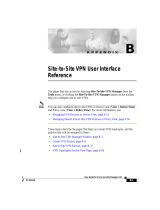
Robustel DMVPN App User Guide
Page 8
Select from “ID”, “FQDN” and “User FQDN” for IKE negotiation. “Default”
stands for “Router’s extern IP”.
ID: Uses custom string as the ID in IKE negotiation.
FQDN: Uses an FQDN type as the ID in IKE negotiation. If this option is
selected, type a name without any at sign (@) for the local security
gateway, e.g., test.robustel.com.
User FQDN: Uses a user FQDN type as the ID in IKE negotiation. If this
option is selected, type a name string with an sign “@” for the local
security gateway, e.g., test@robustel.com.
Select from “DES”, “3DES” and “AES128” to be used in IKE negotiation.
DES: Uses the DES algorithm in CBC mode and 56-bit key.
3DES: Uses the 3DES algorithm in CBC mode and 168-bit key.
AES128: Uses the AES algorithm in CBC mode and 128-bit key.
Select from “MD5” and “SHA1”to be used in IKE negotiation.
MD5: Uses HMAC-SHA1.
SHA1: Uses HMAC-MD5.
Select from “MODP768_1”, “MODP1024_2” and “MODP1536_5”to be
used in key negotiation phase 1.
MODP768_1: Uses the 768-bit Diffie-Hellman group.
MODP1024_2: Uses the 1024-bit Diffie-Hellman group.
MODP1536_5: Uses the 1536-bit Diffie-Hellman group.
Select from “DES”, “3DES” and “AES128” to be used in IKE negotiation.
DES: Uses the DES algorithm in CBC mode and 56-bit key.
3DES: Uses the 3DES algorithm in CBC mode and 168-bit key.
AES128: Uses the AES algorithm in CBC mode and 128-bit key.
Note: Higher security means more complex implementation and lower
speed. DES is enough to meet general requirements. Use 3DES when high
confidentiality and security are required.
SA Authentication
Algorithm
Select from “AH_MD5_96” and “AH_ SHA1_96” when you select “AH” in
“Protocol”; Select from “MD5” and “SHA1”to be used in IKE negotiation.
MD5: Uses HMAC-SHA1.
SHA1: Uses HMAC-MD5.
Select from “PFS_NULL”, “MODP768_1”, “MODP1024_2” and
“MODP1536_5”.
PFS_NULL: Disable PFS Group
MODP768_1: Uses the 768-bit Diffie-Hellman group.
MODP1024_2: Uses the 1024-bit Diffie-Hellman group.
MODP1536_5: Uses the 1536-bit Diffie-Hellman group.
The hold time of Nhrp protocol









